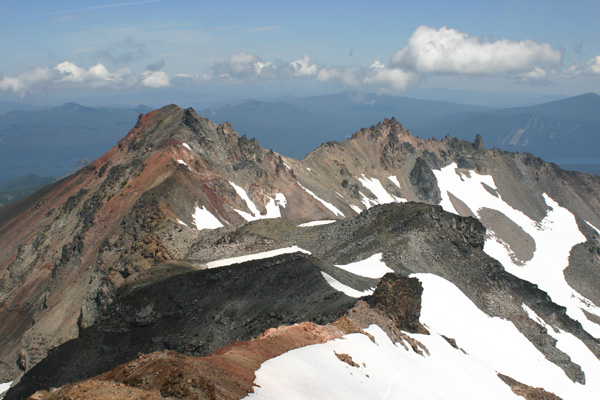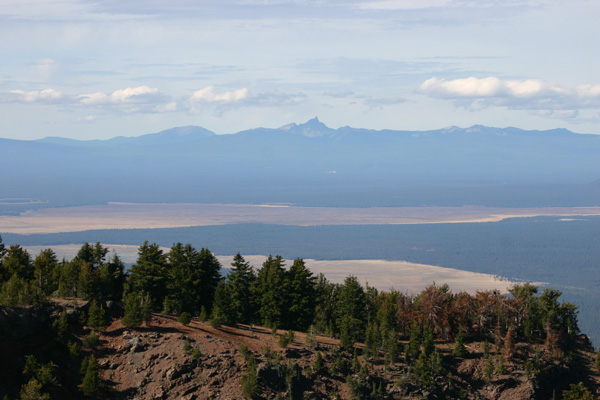This last summer and autumn I finally climbed a few peaks in Southern Oregon as part of my Oregon 100 Highest Peaks project that either I had neglected for many years, or I had not heard of before starting on the project.
More than twenty years ago I skied from Odell Lake along the PCNST and up to the North Summit of Diamond Peak. From that summit I could see the South (true) summit far away across the summit ridge and planned to return someday to visit it. The years passed and other peaks distracted me from returning.
This past August I finally gave Diamond Peak an attempt. The east-side access and South Ridge route descriptions I found described auto travel on rough roads (FSRs 6010 and 380) and cross-country hiking and scrambling through mosquito-infested forest and up talus slopes to reach the summit. It was my first visit to the Summit Lake area and the peak’s southern slopes. The descriptions proved accurate and it was very satisfying to finally visit the summit I had planned for so long to reach.
During August I also finally claimed Pelican Butte and Mount Harriman. Pelican Butte has a closed lookout on the summit. I hiked to the summit via lookout access road (FSR 980) on the west side. It was Sunday and I met several vehicles on my hike, mostly ATVs, but I enjoyed the hike and the good views of Mount McLoughlin and Upper Klamath Lake.
Mount Harriman lies on the northern side of the Mountain Lakes Wilderness. This wilderness lies immediately east of Lake of the Woods in the Southern Oregon Cascades. The terrain was reportedly formed as a 12000 foot volcano that has since been eroded, leaving reminant summits and glacier-carved cirques and lakes. I accessed Mount Harriman from the Varney Creek Trailhead. I followed this trail for a short distance, then turned up the north ridge and began hiking and scrambling through the forest, downed timber, and brush, and and scrambled up talus slopes to the summit. From here I had my first views of Aspen Butte and Mount Carmine and much of the wilderness. I had used GPS tracking, compass bearings, and frequent scanning of the descent route to ensure I could find my way back to the trail and trailhead.
Aspen Butte and Mount Carmine lie on the southern side of the Mountain Lakes Wilderness. I returned the Mountain Lakes Wilderness in late October to climb them. I car-camped overnight at the Clover Creek Trailhead and got an early start the next day. I followed the Clover Creek Trail and the Mountain Lakes Loop Trail to access a climbers’ trail up Aspen Butte. This provided the best view of the Wilderness Area and a good view of my ascent route for Mount Carmine. I descended back to the Mountain Lakes Loop Trail, then dropped down to access and scramble up the southwest ridge of Mount Carmine through open forest and around rock outcrops, then descended to the trail and retraced my route out of the area.
Meanwhile, in mid October I also visited Yamsay Mountain. Yamsay Mountain is a dormant shield volcano with a glacier-carved crater viewable from the summit. The summit is the site of a former lookout tower, and the trail is the former lookout access road that has been heavily carved with water bars (berms) for erosion control and crossed by many downed trees. The open forest along the trail provided alternatives to the road where the downed timber became too tedious to step over. I scrambled up to the summit ridge when it became visible. From here I had views west towards the familiar Cascade Range and in other directions where I recognized only some of the many visible peaks.
My Mount Carmine climb finished the last of the Oregon 100 Highest Peaks in the Oregon Cascades I needed to complete the project. Thirty five years earlier I started climbing the Cascade Peaks, and now my Oregon explorations will decisively shift east towards the Elkhorn Mountains, the Wallowa Mountains, and the isolated peaks of Oregon’s Basin and Range country.




Leave a Reply